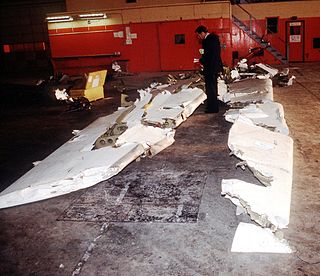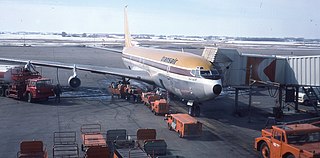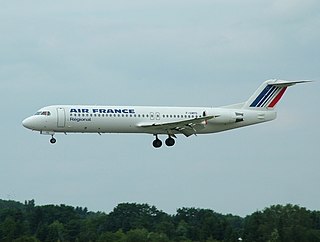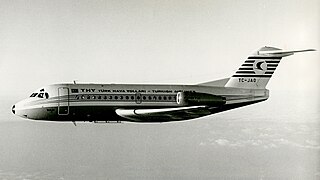This is a list of aviation-related events from 1989.

The Fokker F28 Fellowship is a twin-engined, short-range jet airliner designed and built by Dutch aircraft manufacturer Fokker.

The Fokker 100 is a regional jet that was produced by Fokker in the Netherlands. The Fokker 100 was based on the Fokker F28 with a fuselage stretched by 18.8 ft (5.7 m) to seat up to 109 passengers, up from 85. It is powered by two newer Rolls-Royce Tay turbofans, and it has an updated glass cockpit and a wider wing and tail for increased maximum weights.

Arrow Air Flight 1285R was an international charter flight carrying U.S. Army personnel from Cairo, Egypt, to their home base in Fort Campbell, Kentucky, via Cologne, West Germany, and Gander, Newfoundland. On the morning of Thursday, 12 December 1985, shortly after takeoff from Gander en route to Fort Campbell, the McDonnell Douglas DC-8 serving the flight stalled, crashed, and burned about half a mile from the runway, killing all 248 passengers and 8 crew members on board. As of 2023, it is the deadliest aviation accident to occur on Canadian soil. At the time of the crash, it was the deadliest aviation accident involving a DC-8; as of 2023, it is the second-deadliest, behind the crash of Nigeria Airways Flight 2120 nearly six years later.

Air Florida Flight 90 was a scheduled U.S. domestic passenger flight operated by Air Florida from Washington National Airport to Fort Lauderdale–Hollywood International Airport, with an intermediate stopover at Tampa International Airport. On January 13, 1982, the Boeing 737-222 registered as N62AF crashed into the 14th Street Bridge over the Potomac River just after take off from Washington National Airport.
This is a list of aviation-related events from 1978.
This is a list of aviation-related events from 2003.

Aviation safety is the study and practice of managing risks in aviation. This includes preventing aviation accidents and incidents through research, educating air travel personnel, passengers and the general public, as well as the design of aircraft and aviation infrastructure. The aviation industry is subject to significant regulation and oversight.
Air Ontario Inc. was a Canadian regional airline headquartered in Sarnia then London, Ontario. In 2002, Air Ontario became Air Canada Jazz.

USAir Flight 405 was a regularly scheduled domestic passenger flight between LaGuardia Airport in Queens, New York City, New York, and Cleveland, Ohio. On March 22, 1992, a USAir Fokker F28, registration N485US, flying the route, crashed in poor weather in a partially inverted position in Flushing Bay, shortly after liftoff from LaGuardia. The undercarriage lifted off from the runway, but the airplane failed to gain lift, flying only several meters above the ground. The aircraft then veered off the runway and hit several obstructions before coming to rest in Flushing Bay, just beyond the end of the runway. Of the 51 people on board, 27 were killed, including the captain and a member of the cabin crew.

Continental Airlines Flight 1713 was a commercial airline flight that crashed while taking off in a snowstorm from Stapleton International Airport in Denver, Colorado, on November 15, 1987. The Douglas DC-9 airliner, operated by Continental Airlines, was making a scheduled flight to Boise, Idaho. Twenty-five passengers and three crew members died in the crash.

Dryden Regional Airport is located 4.3 nautical miles northeast of Dryden, Ontario, Canada.

Transair was an airline based in Canada. It was purchased by Pacific Western Airlines in 1979. Transair's operational headquarters was located at the Winnipeg International Airport in Manitoba.
Virgil P. Moshansky, C.M., Q.C., LL.B. is a Canadian judge. Born in Lamont, Alberta, he is a former Justice of the Court of Queen's Bench of Alberta and a former mayor of Vegreville, Alberta.

Palair Macedonian Airlines Flight 301 was a scheduled international passenger flight from Skopje to Zurich, operated by Palair Macedonian, the then-flag carrier of Macedonia, now called North Macedonia. On 5 March 1993, the aircraft operating the flight, a Fokker 100, crashed shortly after taking off from Skopje Airport in snowy conditions. Out of the 97 passengers and crew members on board, only 14 survived. At the time, it was the deadliest air disaster in North Macedonia.

Régional Flight 7775 was a flight from Pau Pyrénées Airport to Paris Charles de Gaulle Airport which crashed shortly after takeoff during wintry conditions. The flight was operated by Air France's regional subsidiary Régional using a Fokker 100. All passengers survived the incident but one person on the ground was killed. An investigation by the BEA determined that the cause of the accident was ice on the wings of the aircraft along with excessive rotation in the weather conditions during takeoff.















